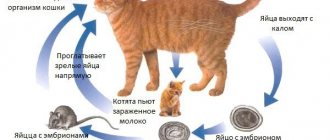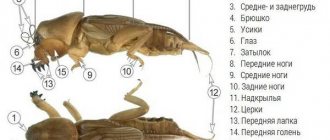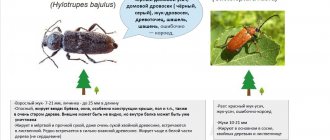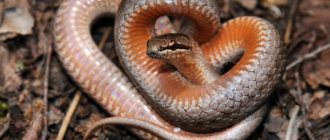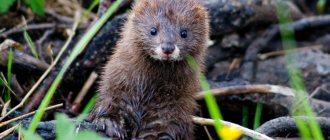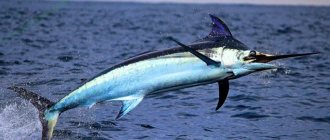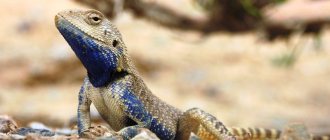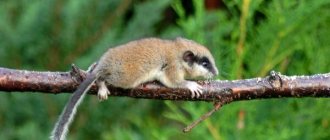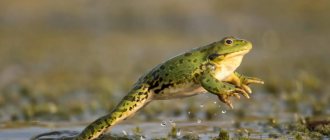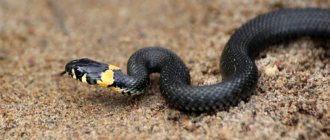- Wild animals
- >>
- Insects
The Colorado potato beetle (Leptinotarsa decemlineata) is an insect belonging to the order Coleoptera and the family of leaf beetles, belongs to the genus Leptinotarsa and is its only representative.
As it turned out, the homeland of this insect is the northeast of Mexico, from where it gradually penetrated into neighboring territories, including the United States, where it quickly adapted to climatic conditions. Over the course of a century and a half, the Colorado potato beetle has spread literally throughout the world and has become the scourge of all potato growers.
What does the Colorado potato beetle, its eggs and larvae look like?
The Colorado potato beetle has characteristic external features. It is almost impossible to confuse it with other parasitic beetles. Depending on the degree of development, the color of the insect is:
- Adults have light elytra with ten black stripes. The body shape is oval, convex, shiny. 8-12 mm long, 6-7 mm wide. The color of the Colorado potato beetle varies from yellow-red to reddish-orange. The antennae are 12-segmented, starting from the base, their thickness gradually increases. The first six segments are yellow, while the others are black. The black legs have elongated, tenacious claws, allowing the pest to migrate unhindered from one bush to another.
- The body of grown larvae is fleshy, sticky to the touch, convex on the outside, swollen in the middle, and flat on the bottom. Color – red-red or brick. The shape is worm-shaped, with sparse bristles on the sides. On the lateral parts of the body there are black spots arranged in two rows. Their length is 15 mm. When the larva is crushed, a bright yellow liquid with an unpleasant odor is released.
- Younger larvae are smaller and yellowish in color. Under favorable weather conditions, when the air temperature is at around +12 degrees, their growth and development proceeds at a rapid pace. In just a couple of weeks, they are able to eat all the green mass on potato bushes, leaving only the stems.
- Insect eggs are bright yellow in color. The surface is shiny, the shape is elongated-oval. They can be from 0.8 to 1.4 mm in length.
Based on these above-mentioned signs, even a novice gardener can identify the Colorado potato beetle by its appearance.
Beetle control methods
Since the beginning of the 20th century, humanity has been actively fighting Colorado potato beetles. A variety of methods are used to destroy a dangerous pest.
Treatment with chemicals
Many effective insecticides have been created to kill the Colorado potato beetle. The most popular among them were the drugs Commander, Actellik 500 EC, Decis, Aktara and Arrivo.
Mechanical method
This method involves collecting insects by hand and is suitable for use at an early stage of infection, when the number of insects has not yet reached a critical level.
Traditional methods
To combat the Colorado potato beetle, experienced farmers use mulching of beds, spraying with infusions and decoctions, as well as planting plants that repel the pest.
Biological method
This method involves the use of biological products based on bacteria and fungi, as well as attracting natural enemies of the Colorado potato beetle to the site.
Origin and distribution
The first to identify and give a detailed description of the Colorado potato beetle was an entomologist and naturalist from the USA, Thomas Seyem (1824). The specimens were collected from the horned nightshade (Solanum rostratum), which grows in the Rocky Mountains. This species was identified as Chrysomela.
In 1858, it was assigned to the American genus Doryphorini by the German entomologist Christian Wilhelm Souffrian. The basis was a large number of similar features.
In 1865, the Colorado potato beetle from this category fell into the genus Leptinotarsa, where it remains to this day. The work was carried out by the popular Swedish researcher Stahl. But in some works, mainly by American entomologists, this species of beetle was called Doryphora decemlineata (late 19th century).
The potato (Colorado) beetle, belonging to the family of leaf beetles (Chrysomelidae), a subfamily of true leaf beetles (Chrysomelinae), gradually entered Europe through the holds of sea vessels transporting potatoes. Already in 1876, this pest was identified in Leipzig, and 30 years later - throughout Western Europe. The exception was Great Britain.
Until 1918, the population of the Colorado potato beetle was contained, but when it settled in Bordeaux (a region of France), where conditions were most favorable for it, breeding centers could not be contained. The insect spread quite actively throughout Western Europe.
In 1940, the potato beetle appeared in the USSR, and 15 years later - in the west of the Ukrainian SSR (Ukraine) and the BSSR (Belarus). In 1975, an insect dangerous for nightshade crops was already in the Urals. Such a rapid migration of the pest was provoked by a long dry period. It was he who became the reason for the delivery of feed to livestock from the territory of Ukraine. In 2000, the beetle ended up in the Primorsky Territory.
If we look at the geographical distribution, the voracious insect is found throughout the European part of Russia - from the Baltic states to the Black Sea coast. It lives in Western Europe, with the exception of England and the Scandinavian Peninsula. The pest attacks agriculture in Central and North America.
Power supply
What does the Colorado potato beetle eat? The main delicacy for him is cultivated nightshade plants, mainly potatoes. These beetles can absorb it in any form. When a young stem appears on the surface, the pest absorbs succulent shoots, and gradually, as the crop grows, it descends to the ripened tubers.
For these reasons, it is very important to start fighting the parasite in time, since its gradual movement throughout the growing crop will lead to its death. From this it becomes clear what harm the Colorado potato beetle causes. And if you take into account the fact that it is increasing its numbers incredibly quickly, then all the fruits growing on your site may be under threat.
The insect begins to eat nightshade foliage in April and its meal can last until August. And if there are no potatoes nearby, then the insect moves to:
- tomatoes;
- eggplant;
- Bell pepper;
- wolfberry;
- henbane;
- physalis.
Moreover, the main pest is not the adult Colorado potato beetle, but its larvae, since their body requires a large amount of energy to develop.
What does the Colorado potato beetle eat?
The basis of the diet of the pest, both adults and larvae, is the above-ground part of the bush. The Colorado potato beetle affects:
- potato;
- eggplant;
- tomatoes;
- Bell pepper;
- tobacco;
- physalis;
- petunia
The insect can also eat wild plants of the Solanaceae family. His favorite foods are potato bushes and eggplants. Considering the high degree of voraciousness of Colorado potato beetles, practically nothing remains of the plant after them. They eat stems, leaves, fruits, and tubers. When going out in search of food, the pest is able to travel dozens of kilometers. The pest has one feature - the ability to withstand hunger for 1.5-2 months. During this period, he hibernates.
Considering that the insect feeds on leaves and shoots of plants from the Solanaceae family, its body contains a high concentration of a toxic substance - solanine. Due to this, the beetle has very few natural enemies. It is of no value to birds and animals due to its toxicity.
Description of the pest
An adult beetle is medium in size - 0.8-1.2 cm long, 0.6-0.7 cm wide. The body is oval-round, convex, yellow-orange in color, with black spots, glossy. The pre-dorsum is also spotted with black spots; there are 5 narrow black stripes running along the elytra. Based on this striped pattern, it is not difficult to distinguish the beetle from other insects. Its wings are well developed, which is why it can fly over fairly long distances.
The larvae are soft, also convex, up to 1.5 cm long, at first, at an early age, they are yellow, then they darken, become orange-red and brown. These colors are due to the fact that, when eating leaves, the larvae cannot digest the carotene contained in them, and it gradually accumulates in their tissues. The larvae have a black head and 2 rows of dots of the same color on both sides of the body.
Adult beetles and especially larvae eat nightshade leaves. Of the cultivated species of this family, they love eggplants and potatoes most of all, but are not averse to settling on tomatoes, physalis, and tobacco. Sweet peppers are chosen last, when there is no more suitable food nearby. You can see what the Colorado potato beetle in the photo.
Life cycle and reproduction of Colorado potato beetles
Only adult individuals go to winter, and in the fall they burrow into the ground to a depth of 0.2-0.5 m. With the arrival of warmth, insects crawl to the surface of the earth, where they look for food in the form of potato sprouts. 3-5 days after the pest emerges from the soil, the mating process begins.
An interesting fact is that the fertilization process can occur not only in spring, but also in autumn. In this case, egg laying begins immediately upon the onset of favorable weather conditions. Females choose the reverse side of leaf blades, where they lay their offspring in groups of 28-30 eggs. One individual can lay up to 80 eggs per day. Throughout the summer period, the productivity of one female varies between 900-1600 eggs, this figure reaches up to 2000 eggs.
The larvae emerge from the eggs after 5-17 days. Before the appearance of the pupa, the final stage of development of the pest, there are 4 stages:
- The first instar larvae eat exclusively the softest part of the leaf from below. They are found on young tender leaves located at the very top of the bush.
- The second instar larvae gnaw out all the flesh, leaving only the thick middle veins.
- Larvae of the third and fourth instars feed quite intensively, attacking plants growing nearby.
After 2-3 weeks, the fourth instar larvae go into the ground to pupate. Often the depth to which they burrow is no more than 10 cm. The appearance of the pupa can be observed after 10-20 days, here everything depends on the temperature of the earth. Adult beetles either “emerge” or enter diapause until the next season. In case of danger, they fall to the ground as if dead.
Features of character and lifestyle
Photo: Colorado potato beetle
The Colorado potato beetle is very prolific, voracious and can quickly adapt to various environmental factors, be it heat or cold. The pest usually survives unfavorable conditions by hibernating for a short time, and can do this at any time of the year.
The young Colorado potato beetle (not the larva) is bright orange in color and has a very soft outer covering. Within 3-4 hours after birth from the pupa, the beetles take on a familiar appearance. The insect immediately begins to feed intensively, eating leaves and shoots, and after 3-4 weeks reaches sexual maturity. Colorado potato beetles that were born in August or later usually hibernate without offspring, but most of them will make up for this loss the following summer.
One of the features unique to this type of beetle is the ability to go into long-term hibernation (diapause), which can last 3 years or even longer. Although the pest flies beautifully, which is facilitated by strong, well-developed wings, in moments of danger for some reason it does not do this, but pretends to be dead, tucking its paws to its abdomen and falling to the ground. Therefore, the enemy has no choice but to simply leave. Meanwhile, the beetle “comes to life” and continues to go about its business.
Natural enemies
The potato beetle is most afraid of the predatory bugs Perillus bioculatus and Podisus maculiventris. These are its main enemies, who love to feast on insect eggs and larvae. Dorifophagous flies, which lay their offspring in the body of the beetle, are also dangerous for the pest. They are common in countries with warm and mild climates; they are not found in Europe and Asia. Ladybugs, ground beetles, lacewing beetles and grasshoppers can also prey on the eggs and larvae of the Colorado potato beetle.
There is an opinion among scientists that for the effective destruction of the pest of all nightshades, its natural enemies, and not agrochemicals, are best suited. This method is not only environmentally friendly, but also more promising.
Among the natural enemies of the potato beetle, in addition to bedbugs and flies, there are also pheasants, turkeys, guinea fowl, and partridges. For poultry, not only the adult generation is of interest, but also their larvae.
Where did it come from?
USA. This is the homeland of the Colorado potato beetle. In 1855, Nebraska farmers who were harvesting their fields discovered a hitherto unknown pest and vegetables that had been badly damaged by it .
Four years later, the beetle was spotted in Colorado. That's when he got his name. The insect quickly invaded North America.
By chance, it was transported along with bales on steamships across the surface of the Atlantic Ocean and left in Europe, where it also took root. The beetle settled in Germany, in the city of Leipzig .
After some time, the pest was exterminated, but after that it was introduced into European countries more than once. Attacks on the Colorado potato beetle were initially successful. And then the First World War began, and the summer residents had no time for it.
The beetle has a strong foothold on the French side, in Bordeaux. When he got bored with this place of residence, he moved on. After a while, all European countries were united by the common problem of pest control. Only England was lucky - although the beetle got there, it is rarely seen on farms.
Reasons for the appearance of the Colorado potato beetle
The Colorado potato beetle settles in a garden or field if:
- The land was not cultivated before planting. Considering that the pest can remain in the ground for several years, in the absence of special means, it will always affect plantings.
- No measures were taken to combat weeds. It is in it that the insect lays its offspring.
- Potatoes were planted in close proximity to tomatoes and eggplants. The best neighbors for potatoes are aromatic herbs (calendula, mint), as well as horseradish.
- There is a natural migration of the beetle from one area to another.
To reduce the likelihood of the Colorado potato beetle appearing in the garden, it is worth planting varieties with a sufficient degree of resistance to the beetle.
Useful tips
You should not rely only on the variety, no matter how resistant it may be. It is much better to prepare the potatoes so that they are inaccessible to the beetle during the season. The first stage is germination of tubers. This is necessary so that the sprouts make their way to the top as quickly as possible.
It is known that the Colorado potato beetle appears on potatoes at a temperature of about 15˚C, and if you plant potatoes early, by this time the bushes will have time to grow powerful tops. Large tubers can be cut into several pieces containing an eye. Each will grow into a whole plant, and the overall harvest will be greater. The cut of the tubers should be sprinkled with sifted ash.
Potatoes must grow in fertilized soil. Receiving enough nutrition, it will be powerful and strong, and it will be easier to resist pests. To create an optimal environment, you need to add fertilizer to the soil - humus and clean wood ash.
The Colorado potato beetle does not bring any benefit, only significant harm. By destroying potato plantations, it reduces crop yields. Various methods have been developed to combat it; to obtain the fastest and most reliable effect, you can not stop at one of them, but use 2 or 3 at once.
Damage caused
Unlike adult specimens, their larvae are the most gluttonous. Under comfortable weather conditions, their development proceeds at a rapid pace. Moreover, the number of eggs increases tens of times.
If you do not fight the pest, then in just a few days the potato bushes may be left without green mass. As a result, tubers do not form and the plant dies. In order to grow not only a quantitative, but also a high-quality crop, one should not neglect methods of prevention and timely treatment of bushes in case of damage to them by parasitic individuals.
How to fight
The Colorado potato beetle is an extremely voracious insect; if no measures are taken to control it, the larvae can eat an impressive portion of the leaves on a bush in a short period of time. As a result, the plant will not be able to develop normally, set and grow tubers. There will be no harvest.
In small areas, you can fight the beetle manually, without the use of chemicals. You can start after planting the potatoes. It should be placed near the cleaning beds. Attracted by the smell, beetles crawling out of the ground will gather on them.
All that remains is to collect the peelings along with the insects, take them outside the beds and destroy them. The time it takes for a beetle to emerge from the soil can take a whole month, so using this method alone is clearly not enough.
The second stage of the fight: inspecting the bushes for the presence of fresh clutches of eggs on them. Since females lay them on the lower leaf blade, it is difficult to notice them right away. You need to lift the leaves, inspect them from below, pick off those on which clutches of eggs are found and also destroy them, collect beetles as soon as they are found on the potatoes and also destroy them.
Ways to get rid of the Colorado potato beetle
You can fight the Colorado potato beetle in different ways. But at the initial stage of damage, it is better to use safer and environmentally friendly drugs. But in case of serious foci of infection, it is important to use chemicals.
Chemical
The market offers a huge range of agrochemicals that allow you to quickly and effectively destroy the potato beetle. But they must be used in strict accordance with the manufacturer's instructions. Do not neglect precautions and exceed the recommended dosage.
It is optimal to process plants in the morning or evening hours. If you use a solution of chemicals in the afternoon, when the peak of sun activity is very high, you can provoke the spread of toxic substances. It is not advisable to constantly use the same products; the pest often develops an addiction to them. In the fight against pests, systemic drugs have proven themselves to be effective; after entering the gastrointestinal tract, they cause the death of the insect.
Among the chemicals that are highly effective against the Colorado potato beetle are:
- Inta-Vir;
- Decis;
- Prestige;
- Fitoverm;
- Karate;
- Tanrek;
- Colorado;
- Bushido;
- Sonnet;
- Regent;
- Aktar.
Mechanical
This method of getting rid of the Nightshade pest will be effective only if its population is small. This includes not only collecting adults and their larvae, but also grinding the laid eggs. It is optimal to go out to inspect young bushes on sunny days, when the temperature is above +14 °C. This is ideal weather for the Colorado potato beetle; it is quite active and easily visible. It is necessary to look not only at the outside, but also at the inside of the leaf; there may be yellow/orange eggs on it.
In order not to miss the moment of the Colorado potato beetle spreading on the site, it is necessary to regularly inspect the plantings and the soil under them. Alternatively, the pest can be collected manually by placing it in a container with a concentrated solution of salt, kerosene, or wood ash.
Agrotechnical
The use of agrotechnical techniques can improve both the growth and development of bushes, and increase their immunity to diseases and pests. The weakest plants are always at risk. To save the future harvest and prevent the appearance of parasitic individuals on the site, you need to adhere to the following recommendations:
- Choose potato varieties that are resistant to the Colorado potato beetle for planting.
- Use exclusively healthy seed material, without signs of rot or disease.
- Follow the rules of crop rotation. By alternating planting, it is possible to stabilize and accumulate organic matter in the soil, as well as to achieve decompaction of the soil and subsurface horizon.
- Destroy weeds.
- Distribute areas away from pumpkin and nightshade crops;
- Do deep digging of the soil in the fall.
- Early ripening varieties should be planted earlier.
- When hilling the sprouts, cover the lower tier of leaves higher.
- Regularly loosen the soil to reduce the population of pupated pests.
- Remove from the site all plant waste remaining after harvesting.
- Mulch the soil with straw and pine needles.
Biological
Unlike insecticides, biological methods are completely safe for both the plant itself and the environment. The harvested crop will be absolutely safe for human health. For the Colorado potato beetle, the most difficult conditions for its existence are created. Protective plants such as marigolds, spring garlic, bush beans, and broad beans are planted between the rows.
In the fight against the Colorado potato beetle they use:
- Bitoxibacillin. The working solution is used to spray bushes in the morning or evening. Repeated manipulation is done after a week. Optimal temperature range +15…+32°C. The main thing is that the air temperature is not below +12 °C. After penetration of the bacteria Bacillus thuringiensis var. Thuringiensis inside the Colorado potato beetle, its ability to fertility and nutrition is lost, lethargy and inactivity appear. An insect with an affected digestive tract dies after 2-4 days. The effect of protein crystals is observed only in an acidic environment with values of 9.5.
- Fitoverm. This is one of the most popular remedies against potato beetles. It is also used by spraying as insects spread during the period of plant growth and development. But it is not always possible to get rid of the pest in one treatment; 2-3 procedures will be required. Considering that the effect of the drug directly depends on external factors, it should be used in clear weather. The interval between treatments is 3-7 days. Plants remain under its protection for 7-20 days. Once inside the insect, the drug immobilizes it and leads to death (after 3-6 days). After 8-10 hours the pest stops feeding.
- Anthonem-F. The intestinal bioinsecticide has proven itself in the fight not only against Colorado potato beetle larvae, but also against wireworms, mole crickets, and thrips larvae/pupae. This concentrate of live nematodes infects insects completely, showing eradicating results of disinfestation. The product is absolutely safe for humans; it is classified as toxicity class 4. One of the advantages of the drug is the long-lasting effect of use; the vital activity of nematodes remains in the soil for up to two years.
Why do parasites appear on the site?
Pests can attack a garden for several reasons:
- Untreated soil. Unprepared soil is very convenient for insects, as Colorado potato beetles overwinter in it.
- Weeds in the garden. Beetles can use weeds as a place to lay eggs.
- Planting potatoes near tomatoes and eggplants. The parasite can spoil all crops that are nearby. It is best to plant aromatic herbs near the potatoes. Pests will be repelled by the strong smell of horseradish or mint.
- Infected neighboring areas. All plants should be inspected regularly for insects. Especially if several plots of land with vegetable gardens are close to each other.
It is preferable to choose an early variety of potatoes for planting. It is more resistant to insects.
Favorable and unfavorable conditions for the pest
The Colorado potato beetle does not have a constant body temperature; its existence depends on the climate in its habitat - heat, moisture and light. The mechanical composition of the soil also affects.
For the successful development of an insect from the egg stage to the adult, the air temperature should be in the range of 24–26 ° C, and the air humidity should be 60–75%. When these indicators change up or down, the development of the population slows down. The number of born larvae decreases both in cold rainy weather and in hot and dry periods. Many first instar larvae die during heavy rainfall and gusty winds. In such conditions, they are unable to move around in search of food.
The pupation process is affected by soil moisture. In hot and compacted soil, some larvae cannot penetrate deeper and die on the surface, and some adults cannot climb up.
With excess soil moisture, pupation occurs in the upper layers of the soil and this also affects the number of young beetles.
Sandy and sandy loam soils are most favorable for the development and wintering of beetles..
Folk remedies
Chemicals are good because they are very effective, but the toxic substances they contain will still enter the human body over time. What to do to avoid harm to health and save the crop from the beetle? The mechanical method is distinguished by its safety and efficiency, but if you have a whole potato field, then it will be very difficult to collect pests by hand. In this case, folk remedies will help get rid of the pest, which are less effective than chemicals, but they certainly will not harm humans. The most effective folk remedies:
- To prepare the infusion, combine 1 bucket of freshly boiled water and 1 kilogram of green fruits and fresh walnut leaves. Cover the container with a lid, and after 7 days the product will be ready, all you have to do is strain it.
- Mix a bucket of very hot water and 300 grams of dried walnut leaves and shells. The mixture, covered, should stand for 7 days, after which it is filtered.
- A bucket of water is combined with 1 kilogram of dried and crushed white acacia bark. After three days, the finished infusion is filtered.
- Fill a bucket halfway with fresh poplar leaves and add water. Let the mixture boil for a quarter of an hour, then increase the volume of the decoction to 10 liters. After three days, the product is drained and used for its intended purpose.
- A liter of water is combined with 10 grams of birch tar, and the resulting solution is sprayed onto the bushes three times over 7 days.
- Ten liters of water are combined with 500 grams of sunflower flowers. After three days, the finished infusion is filtered.
- One and a half kilograms of celandine are combined with very hot water. The product, covered, should sit for three hours. The strained infusion is combined with a solution of calcium chloride (1.5%).
- Fill a bucket with dry or fresh crushed celandine, pour hot water into it and boil the mixture over low heat for a quarter of an hour. The drained broth is used for spraying in diluted form: 0.5 liters of product per 10 liters of water.
- Dry elecampane roots in an amount of 100 grams are crushed and combined with just boiled water; the infusion will be ready after a couple of hours. The first treatment with this infusion is carried out when the bushes reach a height of about 15 centimeters. Experts advise spraying the bushes with this product three times with an interval of one and a half weeks.
- A bucket of water (temperature from 70 to 80 degrees) is combined with 0.3 kilograms of onion peels. A weight is placed on top of the mixture and allowed to brew for 24 hours. Afterwards, the infusion is filtered.
- Pour 0.2 kg of dandelion grass and the same amount of horsetail into a bucket of water, let the mixture boil for a quarter of an hour. The cooled, strained broth is immediately used to spray the bushes.
- 1 tbsp. wood ash is mixed with 0.3 kg of finely chopped fresh wormwood. Boiling water is added to the mixture and left for three hours to infuse, after which it is filtered.
- A liter of water is combined with 10 grams of dry hot pepper. The mixture is boiled for a couple of hours, and after it has cooled, it is filtered and combined with 4 grams of crushed soap. Stir the product until the soap is completely dissolved.
- A bucket of warm water is combined with 1 kg of tomato leaves and shoots, which are pre-chopped. After 4–5 hours, the finished infusion is filtered and mixed with 40 grams of crushed soap (stir the product until it is completely dissolved).
- A bucket of water is combined with three kilograms of tomato tops. The mixture is boiled for about 30 minutes. The cooled, strained broth must be diluted with water before spraying in a ratio of 1:5. In this case, each liter of working solution is combined with four grams of grated soap.
- Dried tobacco roots in an amount of 0.5 kg are combined with 1 bucket of water and left for a couple of days. The finished strained infusion is diluted with water in a ratio of 1:2 and mixed with soap.
- A bucket of water is combined with 0.5 kg of finely chopped tobacco shoots or tobacco dust. The infusion will be ready in a couple of days. Before starting processing, combine 1 part of the product with 2 parts of water and add soap.
- Pour 0.2 kg of finely chopped garlic heads and arrows into a bucket filled with water. The mixture is left to infuse for a while, and then filtered and combined with 40 grams of soap.
Treating bushes against beetles with dry agents is also quite effective. The best folk remedies:
- Sift the wood ash and dust the bushes with it. It is best to use ash obtained by burning birch for this. Before the plants begin to bloom, they are dusted once every 15 days, and when they fade - once every 30 days. The treatment is carried out in the morning, when there is still dew on the foliage or after rain. Approximately 10 kilograms of ash are consumed per 1 hectare.
- Wet foliage can be dusted with cornmeal. This is also a fairly effective way to control the pest.
- To accurately destroy beetle larvae, the bushes should be dusted with cement or plaster.
- The smell of fresh birch or pine sawdust can repel the beetle. Before the bushes bloom, sawdust is scattered between them once every half month, and when they fade - once every 30 days.
How to fight the Colorado potato beetle with folk remedies
